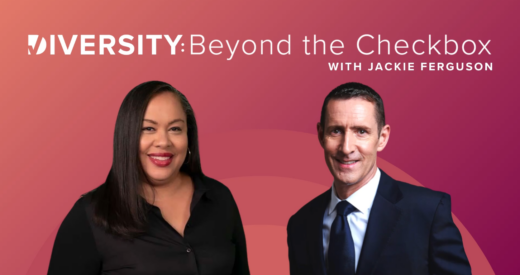If you were asked to think of an outstanding leader, it’s likely they would be an above average communicator. For millennia, the words of great leaders have inspired people to follow them. Charismatic leaders harness their communication skills to connect with their listeners and move them to act.
There’s no question that effective leaders depend on good communication skills, but just because someone has the “gift of gab,” doesn’t mean they are an effective leader. History is also full of rabble-rousers, stone-throwers, and flashy con artists who seek only fame or personal enrichment. In fact, many highly effective leaders prefer to avoid the limelight entirely and focus instead on supporting their team and getting things done.
In fact, high-performing teams are key to succeeding in an increasingly diverse and volatile global economy. Diverse teams – led by individuals with inclusive leadership skills – drive better business results through innovation and improved decision-making. Inclusive leadership capabilities naturally align with diversity, equity, and inclusion (DEI) best practices, which enable leaders to tap into diverse viewpoints and amplify the talents of a diverse workforce. Good communication is essential, and inclusive leaders use their conversational skills to build meaningful relationships with team members, colleagues, and everyone else they encounter.
Leadership Communication in Action

Inclusive leaders cultivate welcoming workplaces where people feel valued, included, and encouraged to contribute their best work. They focus on their teams in order to survive and thrive, and this comes through in their everyday interactions. Conversations are authentic and transparent, and before making decisions, inclusive leaders listen to many perspectives.
“In meetings, it’s very important that leaders speak last and speak less,” says Donald Thompson, CEO and Co-Founder of The Diversity Movement. “Because leadership is still hierarchical, teams have a natural tendency to depend on the leader for answers. It’s up to leaders to become stronger at asking questions – not always having the answers themselves – but asking their team great questions. This gives the team an opportunity to find solutions.”
Inclusive leaders use their conversation skills to build relationships with colleagues and employees, asking about their personal struggles and triumphs. They constantly strive to understand the other person and their lived experience. Inclusive leaders see every conversation as an opportunity to learn something new.
Before Dan Martin, Vice President of Marketing for DHI Group, joined the company’s Pride employee resource group as its executive sponsor, he thought he understood the challenges of the LGBTQ+ community. But, as he listened to individuals describe the obstacles they faced at work and the emotional turmoil caused by anti-LGBTQ+ legislation, he realized how much he didn’t know. He also realized that DHI could do more to support its LGBTQ+ employees. Martin took action, sponsoring changes to the company’s health plan, as well as company-wide educational programming.
“A member of our Pride Group told me that she had never felt more supported, valued, and celebrated than she had working at DHI Group, Inc.,” Martin says. “She also said she turned down three different higher-paying job offers, because feeling safe in a culture that’s inclusive and understanding is more important.”
Keeping an open mind, listening, and building trusted relationships enabled Martin to help create a more inclusive workplace at DHI. The company’s focus on employee well-being also had bottom-line, business benefits.
Why is communication important for inclusive leaders?

Executive leadership teams are increasingly focused on employee retention, and it’s no surprise that happy employees are more likely to stay at a company. A number of studies also show that happy employees are better at their jobs, and they’re more engaged at work. Happy employees are 13% more productive, which translates to an extra 5.2 hours a week or more than 20 hours a month. Cheerful colleagues also drive better outcomes for their whole team.
A recent study by Indeed and Forrester Consulting examines several aspects of well-being at work, including the role that senior leaders and managers play. According to the “Indeed Work Wellbeing Report,” managers especially have a direct impact on worker well-being, with 56% of workers saying they don’t feel supported by their manager, and 73% reporting that feedback is not welcomed by their manager.
The report demonstrates that many companies and leadership teams have work to do if they want to attract and retain top talent. Savvy leaders are moving from the outdated “command-and-control” management model to inclusive leadership – a style that leverages strong relationships, employee well-being, diverse perspectives, and individual respect to achieve outsized results. Key to inclusive leadership is effective communication that involves more than just telling people what to do.
7 Tips for Effective (and Inclusive) Communication with Employees
Communication is a challenge for many people, even very successful ones. Interpersonal communication can be nuanced and misunderstandings happen, even when people are well-intentioned. When this happens, correct the error with kindness or offer apologies with grace. It can also be useful to approach each interaction with this question in mind: “What can I learn from this person?”
- Take time to invest in relationships: Inclusive leaders use their communication skills to build relationships with their team members, colleagues in other departments, C-suite executives, peers and connections in other companies or industries, friends, family and acquaintances. They approach every interaction with an open mind and a willingness to listen and learn. They use inclusive language that shows respect for others and a commitment to honor their individuality. This capacity to build partnerships and form coalitions can drive positive change – whether it’s launching a new product within your organization or serving the larger community.
- Set clear expectations and check for understanding: Leading teams effectively requires setting clear expectations and explaining them with clarity and economy. But good workplace communication doesn’t end there. Inclusive leaders check for understanding, asking questions to make sure everyone is aligned. They are aware of each person’s preferred method of communication, and they use multiple platforms – text, email, phone, or video call – to ensure that their message is understood. Inclusive leaders also make sure the decision-making process includes diverse perspectives from everyone involved.
- Be honest and authentic, even when you’re wrong or uncertain: Honesty, vulnerability, and trust are the hallmarks of an inclusive leader’s communication style. They provide feedback with integrity and candor, and they expect others to respond in kind. These honest and open conversations strengthen relationships and encourage collaboration within teams and across departments. Inclusive leaders are willing to share personal experiences that demonstrate their empathy with others. These authentic stories also reveal the leader’s motivations, perspectives, and priorities.
- Listen more than you speak: Active listening is a hallmark of strong communication. Give the other person your undivided attention, summarize their statements, and ask questions to gain clarity. Recognize the value of diverse viewpoints in sparking innovation, and create opportunities for every team member to share their ideas, perspectives, and concerns. Prioritize inclusive listening as well. Work to attune your ear to different accents or unfamiliar speech patterns. Asking someone “What did you say?” can make someone self-conscious; instead ask, “I’m sorry. Can you please repeat that for me?”
- Be patient and ask open-ended questions: Some people need or want time to process their thoughts before sharing, while others have had years of practice speaking off the cuff. Trained communicators can be challenged by people who are long-winded, speak in a narrative fashion, or take more time to process their thoughts. Strong communicators practice patience and also ask questions to clarify and tease out nuances from those who may be slow or reluctant communicators. “Tell me more” is one of the most useful phrases for inclusive leaders.
- Watch the body language: Body language may convey unspoken messages. Observe cues, such as a furrowed brow, crossed arms, or slumped shoulders, which may indicate concern, defensiveness, or defeat, respectively. Keep in mind that different cultures have unique norms and interpretations of body language. What may be considered polite or respectful in one culture might be seen as offensive or inappropriate in another. For example, making direct eye contact is viewed as a sign of attentiveness in some cultures, but as a challenge or rudeness in others. Ignoring these differences can lead to misunderstandings and conflicts in diverse workplaces.
- Look for ways to improve your communication skills: Just because you are adept at one type of communication, does not mean you don’t have room to grow. If you’re more comfortable expressing yourself in writing, sign up for a public speaking course or volunteer to speak in a public forum. If you can happily speak extemporaneously, but writing is a challenge, offer to contribute a blog post or article on a favorite topic. And always ask for feedback, so you can improve.
Highly effective, inclusive leaders don’t need to have all the answers, but they should have strong communication skills. Good communication enables teams to work together more efficiently. By improving this key leadership capability, leaders can cultivate diverse teams, which can in turn, demonstrate the innovative thinking and agile decision-making necessary in today’s volatile business environment.
Join the ranks of forward-thinking organizations that are harnessing the power of inclusive leadership to build stronger executive and managerial teams. Contact us today to learn how TDM LeaderView can transform your team and allow your organization to thrive.
Bob Batchelor, PhD, is Director of PR and Publications at The Diversity Movement as well as an award-winning cultural historian and author of numerous books, including Stan Lee: The Man Behind Marvel. Connect with him on Linkedin.




